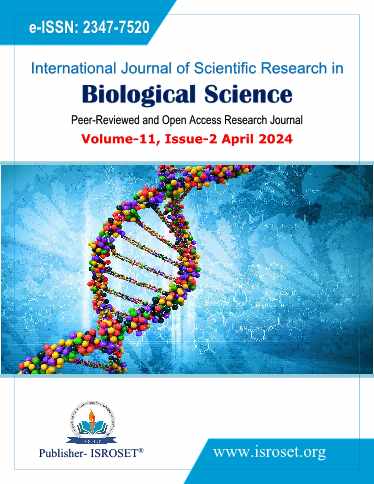Isolation and Characterization of Bacteria for Bio-surfactant production from oil-contaminated and Ffarmland Soil in Dutsin-Ma L.G.A
Keywords:
Biosurfactants, Bacteria, Soil, Screening, Dutsin-MaAbstract
Surface-active substances that are secreted by microorganisms are called biosurfactants. Although there are a number of known microorganisms that create biosurfactants, more research is needed to determine which ones could produce the chemical more quickly and profitably for commercial usage. These kinds of bacteria were identified in the Dutsin-Ma metropolitan investigation as being involved in the production of biosurfactant. Six soil samples in all were gathered from various locations within the Dutsin-Ma city. Six soil samples in all were gathered from various locations within the Dutsin Ma city. The tests included isolating the bacteria, identifying the group to which the organisms belong using gram staining, testing the isolated bacteria biochemically, and performing additional tests to identify bacteria that create biosurfactants. Prior to microscopic examination, the bacteria used in this investigation were first acquired macroscopically. It was noted that several colony characteristics included colour, texture, border, and height. It was noted that B. subtilis had an entire border, a smooth texture, and a yellowish coloration. The isolates` biochemical examination reveals Bacillus subtilis, Pseudomonas sp., and pseudomonas aeruginosa. The fact that the bacteria are there indicates that the soil is a natural habitat for them. based on the biosurfactant activity screening using the oil spread, drop collapse, and haemolysis tests. Every isolate underwent a hemolysis test, and every one of them proved positive (Pseudomonas spp., however, had a negative result). The haemolysis result demonstrates beta hemolysis activity, a sign of the strain`s capacity to generate biosurfactants. With the exception of pseudomonas sp., all isolates showed positive for the drop collapse and oil spread tests. Further research is required to determine the precise features of the type and structure of the biosurfactant that these bacteria eat, based on the results of this study.
References
D.K. Yan., Chakrabarty A. M., Collin M. Screening for the surfactin gene in marine Bacillus strains and its molecular characterization for Bacillus tequilensis. NIOS 11. Turk J Bio. 2013; 37: 212-221, 2012.
A.G. Delgado., Kang D.W., Nelson K.G., D. Fajardo-Williams., J.F. Miceli., H.Y. Done., Popat S.C., R.Krajmalnik-Brown. Selective enrichment yields robust ethene-producing dechlorinating cultures from microcosms stalled at cis-dichloroethene. PLoS One 9:e100654. DOI: 10.1371/journal.pone.0100654, 2014.
R.B. Nielsen., J.D. Keasling Reductive dechlorination of chlorinated ethene DNAPLs by a culture enriched from contaminated groundwater. Biotechnol Bioeng 62:160-5, 2009.
S.J. Barenkamp and J.W. St. Geme III Identification of a second family of high-molecular-weight adhesion proteins expressed by non-typable Haemophilus influenza, Molecular Microbiology, Vol. 19, No. 6, pp. 1215-1223, 1996.
R. R. Colwell., J. D. Walker and J. J. Cooney, Ecological aspects of microbial degradation of petroleum in the marine environment, Critical Reviews in Microbiology. vol. 5, no. 4, pp. 423–445, 2005.
U.S. Environmental Protection Agency. Glossary of technical terms: U.S. Environmental Protection Agency. Pollution Bulletin.101(2):517-525, 2012.
F.H. Chapelle, Ground–water microbiology and geochemistry (2 ed.): New York, New York, John Wiley and Sons, Inc., p. 477, 2001.
T. Ban & T. Sato Aqueous microbial biosurfactant solutions exhibiting ultra-low tension at oil-water inter- faces. Dev. Petr. Sci., 39: 115-25, 2001.
S.J. Barenkamp and J.W. St. Geme III Identification of a second family of high-molecular-weight adhesion proteins expressed by non-typable Haemophilus influenza, Molecular Microbiology, Vol. 19, No. 6, pp. 1215-1223, 1996.
N. Vedaraman., and N.Venkatesh,. Production of surfactin by Bacillus subtilis MTCC 2423 from waste frying oils. Brazi. J. Chem. Eng., 28(2):175–180, 2011.
Oliveira, Juliana Guerra de, and Garcia-Cruz, Crispin Humberto, Properties of a biosurfactant produced by Bacillus pumilus using vinasse and waste frying oil as alternative carbon sources. Brazilian Archives of Biology and Technology, 56(1), 155-160, 2013.
O.A. Emmanuel., O. Kessington., Obahiagbon and Mudiakeoghene,. Biodegradation of vegetable oils: A review, Scientific Research and Essay, 6: 543-548, 2009.
M. Kumar., V., Leon Materno A.D., O.A. Ilzins, Enhancement of oil degradation by co culture of hydrocarbon degrading and biosurfactant producing bacteria. Towards efficient crude oil degradation by a mixed bacterial consortium. Pol. J. Microbiol., 55(2): 139 146, 2006.
N. Popp., M. Schlomann., and Mau, M. Bacterial diversity in the active stage of a bioremediation system for mineral oil hydrocarbon contaminated soils. Microbiol. 152: 3291-3304, 2006.
Downloads
Published
How to Cite
Issue
Section
License

This work is licensed under a Creative Commons Attribution 4.0 International License.
Authors contributing to this journal agree to publish their articles under the Creative Commons Attribution 4.0 International License, allowing third parties to share their work (copy, distribute, transmit) and to adapt it, under the condition that the authors are given credit and that in the event of reuse or distribution, the terms of this license are made clear.







